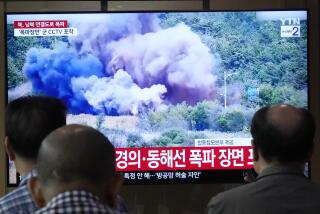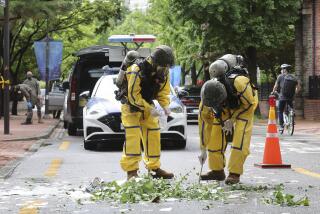Seoul Department Store Collapses; 80 Die : Asia: Building stayed open despite warning signs. More than 900 are injured.
SEOUL — A multilevel department store in one of the most posh neighborhoods of the South Korean capital collapsed Thursday, killing at least 80, injuring more than 900 and trapping an unknown number of others under tons of mangled steel and concrete.
More than 1,000 soldiers, police and rescue workers fought through the rubble amid fires, a cloud of toxic smoke and darkness, as authorities here appealed for and were receiving U.S. military assistance and rescue equipment.
Authorities launched a criminal investigation into the managers of the Sampoong Department Store for faulty construction and negligence.
The structure had 556 shops on nine levels above and below ground--including parking--and more than 700 salespeople.
The disaster’s toll continued to rise today, according to estimates from state-run Korean television.
Witnesses said the store--which opened in 1989, reportedly atop a landfill--began showing cracks in the ceiling and warped floors Thursday morning. Some restaurants in the building then shut down for the day.
*
But Sampoong managers kept the store open, despite holding an emergency meeting about 2 p.m. on the worsening problem, Korean media reported. They reportedly had been aware of problems since early this week, requested a safety inspector three days ago--and, the media here reported, fled shortly before the building collapsed.
About 6 p.m., tragedy struck when the northern half of the massive pink structure began swaying--then quickly gave way.
Restaurant owner Kim So Jung told Korean TV that he was having tea in the building when the floor began caving in. Then the structure began to shake and buckle, creating winds that sent people flying and running for exits.
Kim said he reached the first of four underground levels when the building went down. He managed to crawl out of a hole.
“I saw people running around, bleeding and shouting. It was like hell, like a battlefield,” said Suh Young Joon, a law clerk who was walking home from work when he heard three blasts.
Suh said he ran to the site and carried three unconscious victims to the sidewalk, which was littered with shards of glass, stray shoes and splashes of blood. Nearby, white blouses with dangling price tags hung eerily from trees like ghosts.
Giant cranes worked to pull smashed cars, twisted steel and blocks of concrete from the smoking site. A woman in a red flower dress was pulled out, apparently unharmed, and rushed to a waiting ambulance. “I work at the dispensary,” she said breathlessly, her hair chalk white with dust. “Several people are still down there.”
A car buried in the garage beneath the store burst into flames and spewed a toxic cloud, interrupting rescue efforts. Authorities said the southern half of the block-long structure had swayed five degrees, fueling fears of collapse and halting crane operations.
Residents in a nearby apartment building were evacuated, for fear the unstable ground could cave in.
Early today, crews were able to rescue a woman who, despite her severe dehydration, walked from the wreckage and then collapsed onto a stretcher.
Thursday’s disaster is the latest of several accidents that have shaken this nation in recent months and helped send President Kim Young Sam’s approval ratings plummeting.
Despite the Korean people’s growing reputation as preeminent builders, putting up huge projects in the Mideast and elsewhere, the nation has been hit by a series of baffling incidents in the past nine months: two deadly gas explosions, the collapse of a bridge during rush hour and a fire on an overcrowded river cruise boat. Those accidents killed more than 170 people.
Police were immediately dispatched to the store’s affiliated Sampoong construction company to inspect the building blueprint and question Chairman Lee Joon, the Korean media reported. Authorities also reportedly issued arrest warrants for the store’s top managers based on evidence that they knew of the problems but failed to evacuate the store.
“There were signs from 9 a.m. that there would be an accident,” said Kim, the restaurant owner. At that time, he said, his floors began warping and the ceilings cracked, and he decided to close his shop. In a noodle restaurant on the floor below him, water pipes broke about noon and flooded the shop, he said.
*
The Korean media also reported that police are investigating whether the building’s steel reinforcing bars were below standard. The building was originally allowed to open on a temporary permit only, before inspections were completed, reports here said.
Within an hour of the collapse, Korea’s emergency response teams were swarming over the site with cranes, helicopters and ambulances. Legions of soldiers in camouflage, police in helmets and other workers held back crowds, directed traffic and sought to clear the rubble.
But most of the debris was too heavy to lift. Korean authorities reportedly requested equipment for clearing rubble at night from the U.S. military, which was airlifting it from Hawaii. A military spokesman here could not yet confirm the report but said U.S. forces were providing medical support and metal-cutting teams.
Authorities also publicly appealed for blood donors, drills, water, gloves and other supplies.
Families and friends besieged Seoul hospitals searching for loved ones. At the Samsung Medical Center, Polaroid pictures of unidentified victims, bloodied and battered, were posted on a bulletin board, along with names of those admitted and their condition.
On the hospital’s 10th floor, a Seoul National University student lay quietly in bed, surrounded by family and friends. She said only, “I’m hurting,” before relatives shooed reporters away.
By 11 p.m., the Samsung center had treated about 30 survivors, who arrived by helicopter and car, for injuries ranging from crushed bones and brain damage to shock and trauma, said a hospital official.
At Kangnam St. Marie Hospital, Yoo Young Kyu was searching for his 21-year-old niece, a store employee. He said she came to Seoul three years ago from a village in Kyonggi province. After news of the disaster, her parents in Kyonggi called, pleading for him to find her.
But she was not at Kangnam--or Samsung. As the night grew longer, he set off to visit a third hospital.
Saying authorities should have closed the store, he fumed: “It was greed. They must have been thinking only about money.”
Chi Jung Nam of The Times’ Seoul Bureau contributed to this report.
More to Read
Sign up for Essential California
The most important California stories and recommendations in your inbox every morning.
You may occasionally receive promotional content from the Los Angeles Times.











